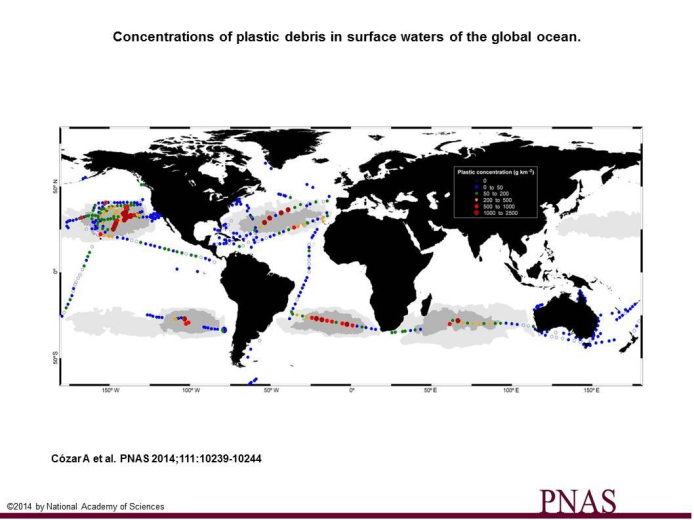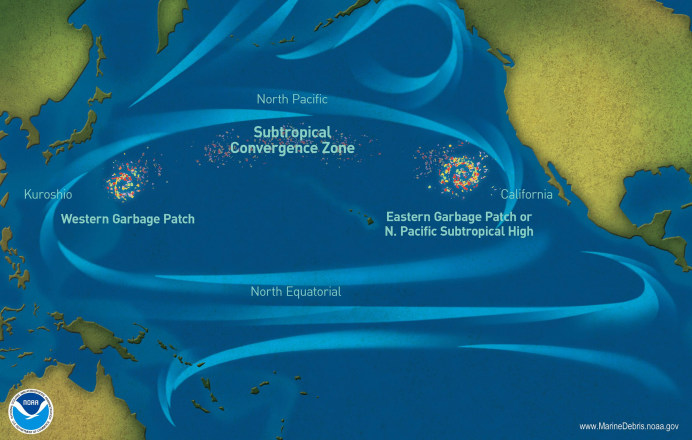Who's flushing plastic pollution into the oceans, creating tiny time bombs that kill fish, birds and sea turtles ingesting what they think is food? That question has been around since 1997, when the "Great Pacific Garbage Patch" was discovered, and a new mathematical model could provide the tool needed to track down the culprits.
The model shows that
pollution can cross what scientists thought were boundaries between
oceans and especially its five gyres — large circular currents that are
now known to trap floating debris in what have been dubbed garbage
patches. Most of that trash is not even visible: It's tiny plastic
pellets floating at or just below the surface.
"The breaking of the
geographic ocean boundaries should shift the way people think of where
oceans begin and end," modeler and mathematician Gary Froyland told NBC
News. "The interactions that we've shown between the different oceans
shows that no ocean is isolated and that local effects can have impacts
far from the source."
Froyland and two
colleagues at the University of New South Wales in Sydney, Australia,
described their model in a paper published Tuesday in the peer-reviewed journal Chaos.
The work builds off an earlier, but less sophisticated, online tool (adrift.org.au) that allows users to project how plastic pollution travels in ocean currents.
The trio's math comes
from a field known as ergodic theory, which has been used to study
interconnectedness — think complex systems like the Internet, or even
humanity.
For their model, the
team divided the entire ocean into seven regions whose waters mix very
little. Their projections tracked well with existing ocean circulation
models and refined those to the point where they found that parts of the
Pacific and Indian oceans are actually most closely coupled to the
south Atlantic, while part of the Indian Ocean really belongs in the
South Pacific.
A follow-up study will
look at how porous those boundaries are. "We first wanted to see where
the boundaries are, the next step is to study the amount of plastic
crossing these boundaries," said Erik van Sebille, an oceanographer with
the team.

Scientists not involved in the modeling welcomed the tool.
"I could imagine using
their model to generate hypotheses about the likely source regions of
debris in each of the 'garbage patches' that could be tested with
on-the-ground sampling in these coastal regions," said Kara Lavender
Law, an oceanographer with the Sea Education Association in Woods Hole,
Mass.
"We already know that
once debris leaves a harbor or coastline it is fairly quickly carried to
the open ocean to these subtropical accumulation zones," she adds, "but
what we might not have guessed is that debris in the accumulation zones
may have originated from the next ocean basin over."
For Spanish marine ecologist Andres Cozar Cabanas, who published a study last July that mapped plastic ocean debris across the globe, the model shows that plastic pollution "is a global issue that can be effectively addressed only … at a global level."
That's exactly how the
Aussie trio want the tool to be used. "At a political level," says
Froyland, "the realization that even the garbage patches exchange
garbage may make governments realize that 'we're all in it together,'
hopefully producing some global action."

NOAA Marine Debris Program
More about Ocean Gyres:
The great Pacific Garbage is a collection of marine debris located in
the North Pacific Ocean. The high-pressure area between the U.S. states
of Hawaii and California is the precipitating factor for the Pacific
Garbage phenomenon. The area lies in then centre of the North Pacific
Subtropical Gyre, which is a circular ocean currents which has been
formed by Earth wind patterns and the forces created by the rotation of
Earth. The middle of the gyre is very calm. The circular motion of the
Gyre pulls in the debris into the center. A similar garbage patch exists
in the Atlantic Ocean, in the North Atlantic Gyre.
No comments:
Post a Comment
Note: Only a member of this blog may post a comment.